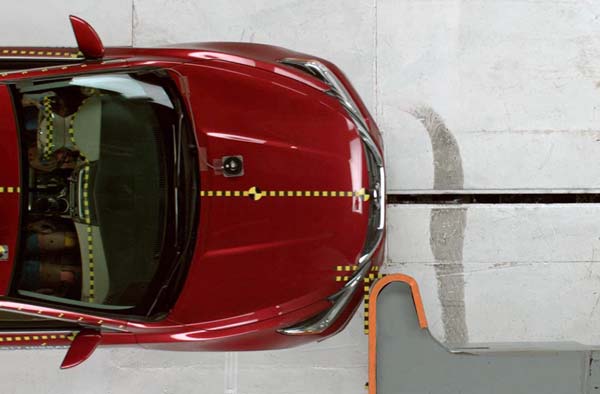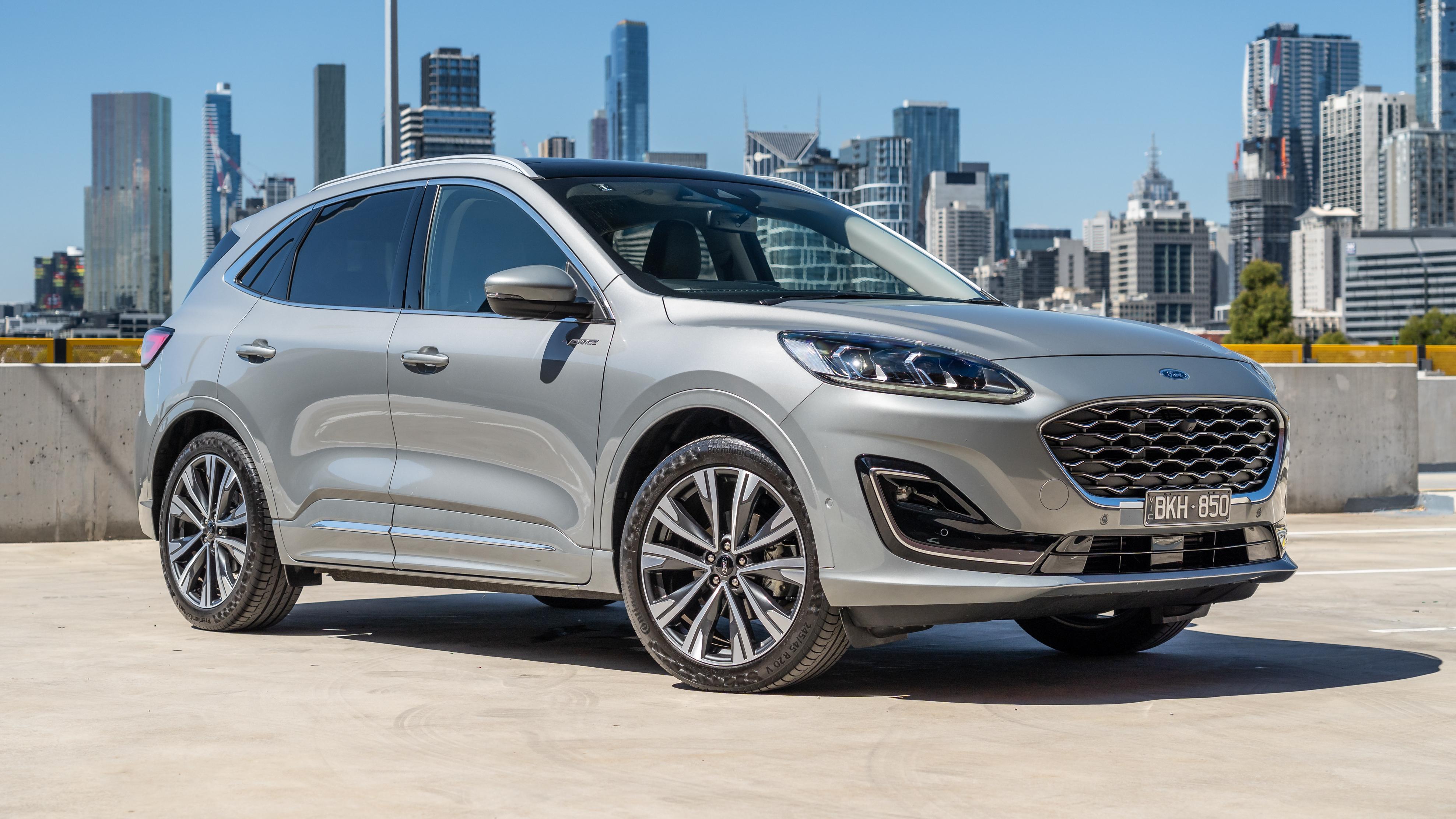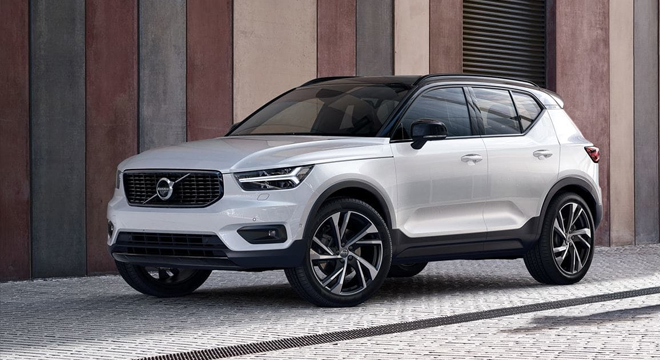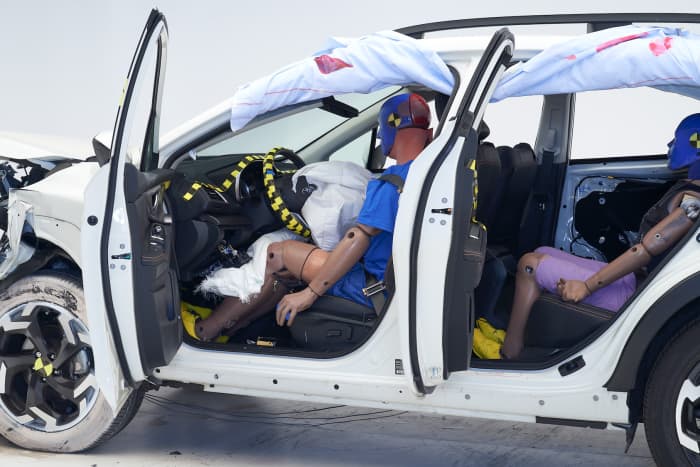Exploring Small SUV Saftey Raitings: Top Models & Features
 When it comes to small SUV safety ratings, there are numerous factors to consider. As car aficionados and SUV drivers, we are aware of the significance of protecting ourselves and our passengers on the roadway. In this blog post, we’ll explore the updated crash test criteria from the IIHS and how automakers have responded to them, as well as rear seat passenger safety concerns and advancements in belt technology.
When it comes to small SUV safety ratings, there are numerous factors to consider. As car aficionados and SUV drivers, we are aware of the significance of protecting ourselves and our passengers on the roadway. In this blog post, we’ll explore the updated crash test criteria from the IIHS and how automakers have responded to them, as well as rear seat passenger safety concerns and advancements in belt technology.
We will also discuss rear seat passenger safety concerns, highlighting injuries faced by backseat occupants and exploring potential improvements that could be made across the industry. Furthermore, we’ll examine advancements in belt technology such as newer designs with sensors that can fine-tune their timings for optimal protection.
Lastly, we will provide an overview of some popular small SUV models with impressive safety features and emphasize the need for industry-wide adoption of backseat passenger safety enhancements. Stay tuned as we take a deep dive into all things related to small SUV safety ratings.
Table of Contents:
- IIHS Updated Moderate-Overlap Front Crash Test
- Changes in the moderate-overlap front crash test
- Top-rated small SUVs under new criteria
- Rear Seat Passenger Safety Concerns
- Belted Occupants’ Risk in Small SUV Crashes
- Newer Belt Designs with Sensors
- Automakers’ Improvements Following IIHS Testing Changes
- Small SUV Models with Good Safety Ratings
- The Need for Industry-Wide Backseat Passenger Safety Improvements
- Frequently Asked Questions Small Suv Saftey Raitings
- Conclusion
IIHS Updated Moderate-Overlap Front Crash Test

The Insurance Institute for Highway Safety (IIHS) has recently updated its moderate-overlap front crash test by adding an occupant to the rear, resulting in only two small SUVs receiving the top score of Good and nine getting a Poor rating. This modification highlights rear-seat passenger safety and aims at urging automakers into making necessary improvements.
Changes in the moderate-overlap front crash test
In previous tests, IIHS focused on evaluating how well vehicles protected their drivers during frontal crashes. However, with this update, they have added a dummy representing a small woman or adolescent seated behind the driver to evaluate vehicle performance in protecting backseat passengers as well.
- New criteria: Vehicles are now assessed based on how effectively they protect both front and rear occupants during crashes.
- Ratings affected: The addition of this new criterion led to changes in ratings for several popular small SUV models like Subaru Forester, Nissan Rogue, Toyota RAV4 among others.
Top-rated small SUVs under new criteria

The latest round of testing revealed that only two out of eleven tested vehicles scored “Good” ratings when it came to protecting backseat passengers – Ford Escape and Volvo XC40. Some other notable mentions include:
- Subaru Forester,
- Nissan Rogue,
- Toyota RAV4, which earned an “Acceptable” rating
- Poor ratings: Jeep Renegade, Hyundai Tucson, Honda CR-V, Audi Q3 and others.
The implementation of a heightened emphasis on the security of those in the backseat is an essential step to guarantee that all riders in small sport utility vehicles are safeguarded during collisions. Automakers must now work towards enhancing their vehicle designs to meet these updated standards set by IIHS.
The new criteria for the IIHS updated moderate-overlap front crash test has been beneficial in identifying top-rated small SUVs, however rear seat passenger safety concerns remain a pressing issue. To address this concern, we must consider the need for better safety features that protect backseat occupants from potential injuries.
Rear Seat Passenger Safety Concerns
Recent studies of real-world crashes have revealed that back-seat passengers often suffer more severe injuries than those seated upfront. According to IIHS President David Harkey, airbags and seat belts have made SUVs safer for front-seat passengers; however, backseat passengers are still at risk due to inadequate protection measures provided by most manufacturers.
Injuries faced by backseat occupants
- Head injuries: Backseat passengers are more likely to experience head trauma in a crash due to the lack of rear airbags or limited coverage from side curtain airbags.
- Chest injuries: The absence of rear seatbelt pre-tensioners and load limiters can result in increased chest compression during an accident, leading to potential internal organ damage.
- Pelvic fractures: Inadequate padding on the lower part of the rear seats may cause pelvic fractures upon impact with the seat belt buckle or other hard surfaces within the vehicle.
The need for better safety features
To address these concerns and improve overall passenger safety, automakers must prioritize implementing advanced technologies such as:
- Rear airbag systems,
- a
- Better-designed side curtain airbags with extended coverage, li >
- Improved seat belt technology including pretensioners and load limiters specifically designed for rear seats , li >
- Enhanced energy-absorbing materials in the back seats and door panels , li >
- Inclusion of rear-seat occupant detection systems for better airbag deployment during crashes . li > ol >By incorporating these features into their vehicles, manufacturers can significantly reduce the risk of injury to backseat passengers in small SUVs like the Subaru Forester, Nissan Rogue, and Toyota RAV4. This will not only improve safety ratings but also provide peace of mind to drivers who want to ensure that all occupants are protected during their journeys.
Given the lack of safety features for rear seat passengers in small SUVs, it is imperative to assess the risks associated with belted occupants during collisions. Therefore, it is essential to evaluate the risks associated with belted occupants in these vehicles during crashes as well.
Key Takeaway: Backseat passengers in small SUVs are at a higher risk of severe injuries due to inadequate protection measures provided by most manufacturers. Automakers must prioritize implementing advanced technologies such as rear airbag systems, better-designed side curtain airbags, improved seat belt technology, enhanced energy-absorbing materials and inclusion of rear-seat occupant detection systems for better airbag deployment during crashes to improve overall passenger safety.
Belted Occupants’ Risk in Small SUV Crashes
It is essential to comprehend the potential dangers connected with these vehicles for all passengers, as small SUVs become more and more popular. The Insurance Institute for Highway Safety (IIHS) has found that belted occupants sitting in the rear seats face a higher risk of fatal injuries compared to those seated upfront. In fact, their findings indicate that the risk of suffering fatal injuries is 46% higher when sitting in the back.
Statistics on Fatality Risks for Belted Occupants
- Nissan Rogue: According to IIHS data, this popular small SUV had a fatality rate of 0.8 per million registered vehicle years among front-seat passengers but an alarming rate of 6.1 among rear-seat passengers.
- Honda CR-V: This model showed similar trends with a fatality rate of 0.7 and 4.9 for front and rear seat passengers respectively.
- Chevrolet Equinox: While boasting better overall safety ratings than its competitors, this vehicle still demonstrated increased risks at 1.5 fatalities per million registered vehicle years upfront and 4 deaths per million in the backseat area.
The statistics clearly show that there’s room for improvement when it comes to protecting all occupants within small SUVs such as Nissan Rogue, Honda CR-V, Chevrolet Equinox and others alike .
Importance of Improving Overall Vehicle Safety
In light of these concerning figures , industry experts emphasize on proactively addressing safety features not just limited to drivers alone but also ensuring adequate protection measures are provided across various seating positions within the vehicle. For instance, Subaru Forester and Toyota RAV4 have already taken steps to improve rear seat safety by incorporating features such as side airbags for backseat passengers.
Other automakers must follow suit in prioritizing the safety of all occupants within their vehicles. This includes enhancing existing protection measures like seat belts, airbags and head restraints while also exploring innovative technologies that can further minimize injury risks during collisions . By doing so , not only will manufacturers be able to meet the ever-evolving standards set forth by organizations like IIHS but also ensure a safer driving experience for everyone on board regardless of where they sit inside the car.
The importance of improving the overall safety rating for small SUVs cannot be overstated, as belted occupants’ risk in crashes can have life-altering consequences. With newer belt designs featuring sensors and other advanced technology, we are now able to fine-tune sensor timings for even greater protection.
Key Takeaway: Small SUVs have gained popularity but belted occupants sitting in the rear seats face a higher risk of fatal injuries compared to those seated upfront. Statistics show that there’s room for improvement when it comes to protecting all occupants within small SUVs, and automakers must prioritize safety measures such as enhancing existing protection measures like seat belts, airbags and head restraints while also exploring innovative technologies that can further minimize injury risks during collisions.
Newer Belt Designs with Sensors

As the need for improved rear seat passenger safety becomes more apparent, automakers are turning to innovative solutions. One such advancement in belt technology is the incorporation of sensors within seat belts. These sensors can detect an imminent crash and pull passengers into a proper seating position just before impact occurs. This not only helps reduce injuries but also ensures that occupants are better protected during collisions.
Advancements in Belt Technology
- Pre-tensioners: Modern seat belts now come equipped with pre-tensioners that automatically tighten the belt upon detecting rapid deceleration or forceful impact, keeping passengers firmly secured.
- Load limiters: To prevent excessive force on the occupant’s chest during a collision, load limiters help control the amount of pressure exerted by releasing some slack when necessary.
- Inflatable belts: Some manufacturers like Ford have introduced inflatable seatbelts designed to distribute forces across a larger area of the body, reducing injury risk for backseat passengers – particularly children and small adults.
Fine-Tuning Sensor Timings
The effectiveness of these advanced safety features largely depends on their ability to respond quickly and accurately during crashes. As such, it is crucial for automakers to fine-tune sensor timings so that they activate at precisely the right moment. By doing so, vehicles can provide optimal protection for all occupants – regardless of whether they’re seated upfront or in back seats.
An example worth noting is how Subaru Forester has managed to achieve impressive results through its EyeSight Driver Assist Technology. This system utilizes cameras and sensors to monitor traffic conditions, providing timely warnings and even applying brakes when necessary. In fact, the Subaru Forester has been awarded a Top Safety Pick+ rating by IIHS – the highest possible accolade.
As more automakers adopt similar technologies in their vehicles, it is essential for them to prioritize rear seat passenger safety alongside driver protection features. It is critical that auto manufacturers include rear seat passenger safety in their vehicles, alongside driver protection features, to ensure everyone inside the car can have a secure journey.
The newer belt designs with sensors have provided an increased level of safety, but there is still room for improvement. Automakers are responding to the IIHS test changes by making necessary improvements in order to ensure vehicle safety standards remain high.
Key Takeaway: Automakers are incorporating innovative solutions to improve rear seat passenger safety, such as sensors within seat belts that detect an imminent crash and pull passengers into a proper seating position just before impact. Advanced safety features like pre-tensioners, load limiters, and inflatable belts can help reduce injuries during collisions. Subaru Forester’s EyeSight Driver Assist Technology has achieved impressive results in monitoring traffic conditions and providing timely warnings for optimal protection of all occupants.
Automakers’ Improvements Following IIHS Testing Changes
According to David Harkey, the president of IIHS, they believe that manufacturers will respond positively to these changes and adapt quickly as they have done so in the past.
Past Responses of Automakers to IIHS Test Changes
In previous years, automakers have made significant strides in response to updated testing criteria from the IIHS. For instance, when side impact crash tests were introduced by the institute back in 2003, many vehicles initially performed poorly; however, within just a few years most models saw vast improvements due to redesigned side structures and airbags specifically tailored for side impacts.
Similarly, after introducing their small overlap front crash test in 2012 which focused on collisions affecting only a small portion of the vehicle’s front end—such as hitting a tree or utility pole—automakers responded by strengthening vehicle structures and improving frontal airbag systems leading to better performance during subsequent evaluations.
Expectations for Future Vehicle Safety Enhancements
- Newer Belt Designs with Sensors: As mentioned earlier under Heading 4 description above , newer belt designs now incorporate sensors capable of detecting imminent crashes thereby pulling passengers into proper seating positions just before impact occurs . However ,the timing of these rear safety belts needs fine-tuning for better functionality during crashes.
- Improved Rear Seat Airbags: Another area of potential improvement is the development and implementation of advanced rear seat airbag systems that provide better protection for backseat passengers during various types of collisions.
- Rear Seatbelt Pretensioners: Manufacturers could also focus on incorporating pretensioners in rear seatbelts, which work by tightening the belt to remove any slack just before a crash occurs, thus reducing the risk of injury from sudden jolting movements.
With automakers’ history of responding positively to IIHS testing changes and making necessary improvements in vehicle safety features, it’s expected that they will continue this trend by focusing more on enhancing backseat passenger safety. This would ensure a safer driving experience for all occupants within their vehicles sold, regardless of where they sit inside the car.
Automakers have made significant improvements in the safety of their vehicles since the introduction of IIHS testing changes, and these advancements are likely to continue as they strive for better ratings. Small SUV models such as the Ford Escape and Volvo XC40 provide excellent safety features that make them stand out from other cars on the market.
Key Takeaway: Automakers have responded positively to changes in IIHS testing criteria by making necessary safety improvements, such as redesigning side structures and airbags for side impacts. Future enhancements could include improved rear seat airbag systems, pretensioners in rear seatbelts, and newer belt designs with sensors capable of detecting imminent crashes.
Small SUV Models with Good Safety Ratings
The Ford Escape and Volvo XC40 are among the small SUVs that received “good” ratings under the new criterion set by IIHS, highlighting their focus on ensuring adequate protection measures not only for drivers but also rear-seat passengers. Let’s take a closer look at these two models’ safety features.
Ford Escape’s Safety Features

The Ford Escape is designed with a range of sophisticated safety features to keep all passengers safe. Some of its notable features include:
- Ford Co-Pilot360 Technology: This suite of driver-assist technologies includes Pre-Collision Assist with Automatic Emergency Braking, Blind Spot Information System (BLIS) with Cross-Traffic Alert, Lane-Keeping System, Rear View Camera, and Auto High-Beam Headlamps.
- Safety Canopy System: The side-curtain airbags in this system provide enhanced head protection for both front and rear seat occupants during side impacts or rollovers.
- LATCH (Lower Anchors and Tethers for Children): This feature helps secure child safety seats in the back seats properly to reduce the risk of injury during accidents.
- Tire Pressure Monitoring System (TPMS): TPMS alerts you when your tires need inflation to maintain optimal tire pressure levels which can help prevent blowouts or flats while driving.
Volvo XC40’s Safety Features

In line with Volvo’s reputation as a leader in automotive safety innovation, the Volvo XC40 boasts a range of advanced safety features that cater to both front and rear seat passengers. Some key highlights include:
- City Safety Collision Avoidance Technology: This system uses radar and camera technology to detect potential collisions with other vehicles, pedestrians, cyclists, or large animals in your path. It can provide warnings and even apply the brakes if necessary.
- Rear Cross-Traffic Alert with Braking Support: When reversing out of tight spaces, this feature warns you about approaching traffic from either side while also applying the brakes if needed.
- Inflatable Curtain Airbags (IC): These airbags protect occupants’ heads during side impacts or rollovers by deploying from the roof lining on both sides of the vehicle.
- SIPS (Side Impact Protection System): SIPS is designed to distribute crash forces away from occupants during side-impact collisions through reinforced body structure elements and energy-absorbing materials within doors.
The Ford Escape and Volvo XC40’s impressive safety ratings demonstrate their commitment towards ensuring comprehensive protection for all passengers inside their vehicles. As more automakers follow suit in prioritizing backseat passenger safety enhancements alongside driver protection measures, we can expect a safer driving experience for everyone on board regardless of where they sit inside an SUV.
Small SUVs with good safety ratings can give drivers and passengers a sense of security while driving, but there is still room to enhance backseat passenger protection. The next heading will discuss potential enhancements that could be made in order to increase overall industry-wide adoption of improved backseat passenger protection standards.
Key Takeaway: The Ford Escape and Volvo XC40 are small SUV models with good safety ratings, receiving “good” ratings under the new criterion set by IIHS. They both have advanced safety technologies that ensure maximum protection for all occupants, including driver-assist technologies and side-curtain airbags.
The Need for Industry-Wide Backseat Passenger Safety Improvements
As the importance of rear-seat passenger safety becomes more apparent, it is crucial that automobile companies prioritize backseat protection features alongside driver-focused enhancements within their vehicles. By doing so, a safer driving experience can be ensured for all occupants, regardless of where they sit inside the car.
Examples of Potential Backseat Passenger Safety Enhancements
- Inflatable seat belts: These innovative seat belts incorporate airbags to provide additional cushioning during a crash and help distribute impact forces across a larger area. The Ford Escape, one of the small SUVs with good safety ratings from IIHS, offers this feature as an option.
- Rear side airbags: Adding side curtain airbags or torso-protecting airbags in the rear seats can significantly reduce injuries sustained by passengers during side-impact collisions. Vehicles like the Volvo XC40 come equipped with these types of airbags.
- Better head restraints: Properly designed and adjustable head restraints are essential in preventing whiplash injuries during rear-end crashes. Automakers should ensure that their vehicles have adequate head restraint systems for both front and rear seats.
- Rear pre-crash warning systems: Similar to forward collision warning systems available for drivers, implementing technology that alerts passengers about potential collisions could allow them time to brace themselves before impact occurs.
Importance of Industry-Wide Adoption
While some automakers, such as Subaru, Nissan, and Toyota, have already started incorporating advanced safety features in their small SUV models like the Forester, Rogue, and RAV4 respectively, it is essential for other manufacturers to follow suit. By adopting these enhancements industry-wide, we can collectively work towards reducing the number of fatalities and injuries sustained by rear-seat passengers during accidents.
As consumers become more aware of the need for improved backseat passenger safety measures in vehicles sold today – from compact options like the Jeep Renegade or Hyundai Tucson to larger models such as the Honda CR-V or Audi Q3 – they will undoubtedly begin demanding better protection systems from automakers. This should prompt a shift in the auto industry and ultimately result in more secure vehicles on our streets.
Key Takeaway: Automobile companies need to prioritize backseat protection features alongside driver-focused enhancements within their vehicles. Potential safety enhancements include inflatable seat belts, rear side airbags, better head restraints and rear pre-crash warning systems. Industry-wide adoption of these measures is essential to reduce fatalities and injuries sustained by rear-seat passengers during accidents.
Frequently Asked Questions Small Suv Saftey Raitings
Are small SUVs safer?
Small SUVs can be quite safe, but their safety depends on various factors such as crash test ratings, safety features, and vehicle design. Some small SUVs have excellent NHTSA, IIHS, and Euro NCAP ratings, making them a secure choice for drivers.
What small SUV has the highest rating?
The Honda CR-V, Toyota RAV4, and Subaru Forester are among the top-rated small SUVs for safety in 2023. These vehicles have received high scores from organizations like NHTSA and IIHS due to their advanced safety features and strong performance in crash tests.
Are small SUVs safer than large SUVs?
The size of an SUV does not necessarily determine its overall safety level. Both large and small-sized SUVS can offer good protection if they possess strong crash test ratings along with essential driver assistance systems (ADAS). However, larger vehicles may provide better protection during collisions due to their mass advantage.
Which SUVs failed the crash test?
Few modern-day popular models fail outright in major crash tests conducted by organizations like NHTSA or IIHS; however some might receive lower scores compared to others within specific categories. To find out more about individual model performances visit official websites of NHTSA, IIHS, or Euro NCAP.
Conclusion
Small SUVs offer an attractive combination of practicality and safety. With their increased size, they can often perform better in crash tests than smaller cars. However, it is important to research the various models available before making a purchase decision as some small SUVs have higher safety ratings than others. By understanding common features that improve small SUV saftey raitings and researching top rated models for 2023, you can make sure your family has the safest possible ride when driving a small SUV.
Discover the latest small SUV safety ratings and compare prices to make an informed decision when selecting your next vehicle. Act now for peace of mind on the road!
